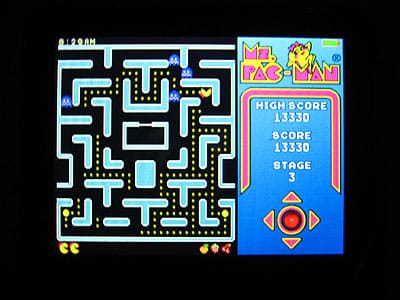Updated! There are people out there who would accuse the iPod of being a mediocre gaming platform, and regrettably, Namco’s September 2006 release of Pac-Man (iLounge rating: D+) was that viewpoint’s poster child – a 25-year-old arcade game rendered less fun by dodgy iPod Click Wheel controls. This week’s newly-released sequel Ms. Pac-Man ($5) is generally more of the same, only with slightly better graphics and gameplay. Some fans of these classic pellet-munching, ghost-evading maze games will find Ms. Pac-Man engaging in brief spurts, but others will continue to be frustrated by the iPod’s imprecise controls.

Originally released as an unauthorized sequel by Namco’s American distributor Midway in 1981 – when Pac-Man fever was in full swing but without an official, Japanese-developed Namco follow-up at the ready – Ms. Pac-Man borrowed ideas from unauthorized hacks of the Pac-Man chipset, adding colorful new mazes, higher speeds, and less predictable ghost patterns to the prior game’s mix. The result was a game that was harder to complete – actually impossible, as it would crash around stage 134 of 256, thanks to a bug – but arguably even more popular than its predecessor in the United States. Midway’s decision to use a female, red-bowed version of Pac-Man helped broaden the game’s appeal, and its addition of moving bonus snacks such as hot pretzels and female ghost Sue were also much-noted changes.

By iPod port standards, Ms. Pac-Man’s only significant issues are control-related. Graphically, it’s a very close approximation of the arcade original, with slight visual tweaks – off-maze score and icon placement – that only the most hardened purists will mind. Namco has also preserved the original’s occasional, modestly amusing romantic between-stage cinematics, but displays them so quickly that newcomers mightn’t get what’s going on. Sonically, it’s essentially the same as the arcade game, except for a sped-up sound effect bug we experienced and couldn’t easily reproduce, and the standard iPod ability to play your own music in the background.
Fans will be glad that they still get the two-colored mazes and all the speed of the arcade original, the latter modulated by a difficulty adjustment setting: “easy” and “normal” both feel slower than “original,” which puts a premium on quick turns and strategic dot-gobbling. On the easiest setting, the ghosts are less aggressive and you’ll have extra opportunity to evade or eat them; original mode is comparatively unforgiving.


Namco thankfully moderates the game’s challenge with two features that essentially let you continue playing as far through the game as you want. Armed with four spare Ms. Pac-Men on easy, three on normal, or two on original, you have plenty of chances to remove all the dots from a given level, and multiple “continues” or “credits” to try again if you fail. The continues aren’t super-important, though, as you can always start a new game at the highest level you’ve previously reached – all that’s keeping you from level 256 is your skill, and some luck.

Unfortunately, because of a carried-over control scheme we didn’t like in Pac-Man, you’ll need at least as much luck as skill to advance through the levels here – arguably more. Ms. Pac-Man’s faster pace makes rapid changes of direction absolutely critical to success, and though the game puts up a brief tutorial to help acquaint you with the faux joystick – touch, but don’t depress the Click Wheel, and watch the current position on the bottom right side of the screen – it’s not enough to render this game fully enjoyable. Starting instantly, but becoming really problematic around stage 5 or 7, depending on the difficulty setting, you’ll find yourself repeatedly dying from failing to make turns you tried to signal, a problem that becomes considerably more punishing as everything speeds up and ghosts stop turning blue. In any game, but especially in the speed-intensive Ms. Pac-Man, more precise control than this is critical – a joystick or joypad would have done a lot better here.

Our overall feeling is that Ms. Pac-Man is a little better of an iPod game overall than its predecessor; the new mazes, intermissions, and modestly enhanced graphics make it easier on the eyes, and the gameplay tweaks add extra excitement and replayability to the prior title. But to the extent that it’s saddled with the same control issues that plagued the iPod version of Pac-Man – ones that will make the game feel increasingly unfair as levels progress and precision becomes more critical – it’s not a title we’d generally recommend to our readers.
As we’ve said before, we’re huge fans of Namco and its games, but a more consistent control scheme or accessory controller will be all but necessary for any twitch-dependent title such as this to feel “right” in our hands.

Update: Our original review of Ms. Pac-Man for the iPod was published on February 27, 2007. On July 30, 2008, iLounge published iPhone Gems: Cards, Gambling + Arcade-Style Games, a feature article looking at seven assorted games developed for the iPhone OS, including an iPhone version of this title. Our new review appears below.

We’ve said it before and we’ll say it again: Namco’s one of our all-time favorite game developers, but the games it’s releasing for iPods and iPhones are seriously unimpressive. In 2006, Namco released the early dot-gobbling maze game Pac-Man for Click Wheel iPods, following it up with the early 2007 release of Ms. Pac-Man, and the 2008 release of Pole Position—all roughly 25-year-old arcade games that hardly seemed worth their $5 asking prices. This month, Namco re-released Pac-Man and Ms. Pac-Man for the iPhone and iPod touch, doubling their prices to $10, and doing little to justify the price increases.

Ms. Pac-Man for the iPhone and iPod touch, like Pac-Man, is a nothing special port to the iPhone OS. While the Click Wheel iPods suffered from a single poor control scheme, Namco now includes three for the iPod touch and iPhone. Swipe Mode lets you “swipe your finger across the screen to move Ms. Pac-Man in that direction;” D-Pad Mode places a four-way directional pad on the bottom of the screen, and Accelerometer Mode lets you “play by leaning or rotating the device in the direction that you want Ms.












